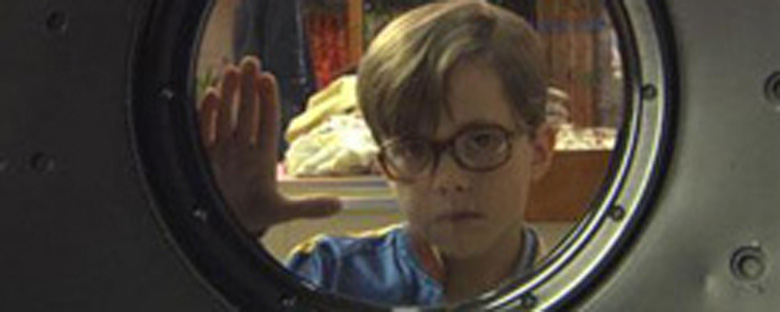Reviews
La Face Cachée de la Lune
Robert Lepage
Canada, 2004
Credits
Review by Adam Balz
Posted on 05 June 2006
Source TLA Releasing DVD
When we describe the moon as dead, we are describing the deadness in ourselves. When we find space so hideously void, we are describing our own unbearable emptiness.
—D.H. Lawrence
The Far Side of the Moon, Robert Lepage’s illusory portrait of fascination and dejection, opens with a short history of lunar exploration. According to the narrator, “…In the 20th century, when the first Soviet lunar probe sent back images of the far side we never see, the world was stunned to find the moon had a second visage, more deeply scarred by the pounding of meteorites and other celestial debris. NASA scientists liked to call it, ‘the disfigured face of the moon.’” The notion that this one massive, unsustainable stone has taken the brunt of space’s exactions for Earth is near incomprehensible. That we’ve faced catastrophe for centuries, only to have the impending disaster thwarted by the perpetually hidden half of our moon, almost seems like a nonsensical invention of Vonnegut or Lem. Nonetheless, it’s a theme that recurs throughout the film—one large, unfaltering presence sustaining the impact of harsh inevitabilities, only to keep those scars hidden.
As portrayed in a fascinating dual performances by writer-director Robert Lepage, Phillippe and Andre are distant brothers living in Quebec. The former is a polished telemarketer and wannabe scholar who believes the decades of international space exploration arose out of narcissism, while the latter is a gay meteorologist whose only concerns lie in what to do with his dead mother’s things. (She, as we later discover, was a complex woman whose outward ostentation hid some rather telling compassion, someone who abided by the conventions of motherhood in private while taking on the role with mannequin-like unresponsiveness in public; later stricken with an illness, she loses what Phillippe considers her true beauty.) Lepage, using lunar symbols, associates Phillippe and Andre’s upbringing with space travel. Phillippe’s fascination with laundromat dryers translates into fantastic delusions about a space capsule departing for the moon; later, he sees his yet unborn brother as an astronaut tethered to his craft rather than a child bound to his mother.
So whom or what does the moon represent? Any answer belies the outward starkness of the titular symbol’s two faces. It’s possible the moon is Phillippe—bland, expressionless, suffering a scarred identity hidden in shadows. Andre, on the other hand, has taken the brunt of his mother’s life; while Phillippe lived in blithe self-interest about his mother’s collapse, Andre knew the truth. The moon, of course, could be both brothers. We first believe that Andre, the primed and compassionate TV weatherman, is the unscarred and visible success, whereas Phillippe has taken the brunt of life and now hides behind a curtain of failure, earning pittance in the distant and loathsome profession of telemarketer. Only later do the roles reverse, and we become aware of the burden Andre’s carried for the sake of his brother.
But literature has always identified the moon as feminine. Poets like Sylvia Plath, William Butler Yeats, and Robert Frost have referred to Earth’s gray satellite rather tellingly as “her,” “mother.” Perhaps Lepage himself has taken up the literary association, connecting Phillippe and Andre’s mother to the seen-versus-hidden, picturesque-versus-damaged moon. A scene later in the film—a mere minute or two which alternates between the past and present—is perfectly germane to the idea of a bilateral life. Phillippe, reading a reflective poem about a mother, is shown as a young boy, his head on his mother’s lap; we then see him again sitting beside her in almost the same eerie, stoic pose, only now she’s an elderly amputee and he wears the expression of a failure. As D.H. Lawrence wrote, “The moon is a white strange world, great, white, soft-seeming globe in the night sky, and what she actually communicates to me across space I shall never fully know.”
The moon is the conductor of nature and the subject of tragedy, yet we can hardly profess an understanding simply because we’ve composed tomes of literature about it; the men and women sent into space to observe and explore it have in essence studied a minute fraction of its being. Just because we’ve spent millennia under the stars, watching the moon ascend the sky, caught in the same orbit around us and arc above us, we mustn’t behave as though we’ve learned all. Lepage’s Phillippe claims to know why nations laid their futures at the alter of space, and he’s ultimately proven wrong. He walks through life thinking he understands everything about his mother, simply because he grew up with her; tragedy challenges him. He trusts others, including his own brother and a famed cosmonaut, but is let down repeatedly. Phillippe’s life, much like the poem he reads, is heartbreaking.
No matter the interpretation, The Far Side of the Moon relies on a brilliant visual complexity that helps the storyline more than any flashback or monologue could, something attributable to Lepage’s history with the stage. Not only did Lepage create the original play, but he’s also responsible for Ka, a branch of the Cirque du Soleil franchise from which much of the soundtrack is derived. The only true problem is a lack of finality. As the film ends, we’re left wondering what becomes of both Phillippe and Andre as the former figuratively (and perhaps literally) floats away.
We don’t do comments anymore, but you may contact us here or find us on Twitter or Facebook.



